Good day, anatomy students! Welcome to Anatomy Lesson #57, Fergus and the Phantom Limb.
Several readers have requested today’s topic… an exploration of the consequences of the fateful encounter twixt Fergus and Corporal MacGregor – Starz ep 302, Surrender
Warning! Readers may find a few images in this lesson a bit unsettling. But, rest assured, if you watched ep 302, you have seen the iffy images before. Also, this lesson must contain some neuroscience which, because of its complexity, is a challenge. Thus, explanations are distilled to bare essentials so all may understand. Hope this works for every reader!
Now, for the record, who is Corporal MacGregor (Ryan Fletcher)? Not a Voyager book character, this man is an invention by TV writer Anne Kenney and team: a Lowland Scot who identifies more with the English than fellow Highlanders. He takes an instant dislike to Lallybroch and its denizens – threatening little Jamie with a back-hand slap and disparaging Fergus as a –
filthy frog eater… Mind your tongue or I’ll cut it out!
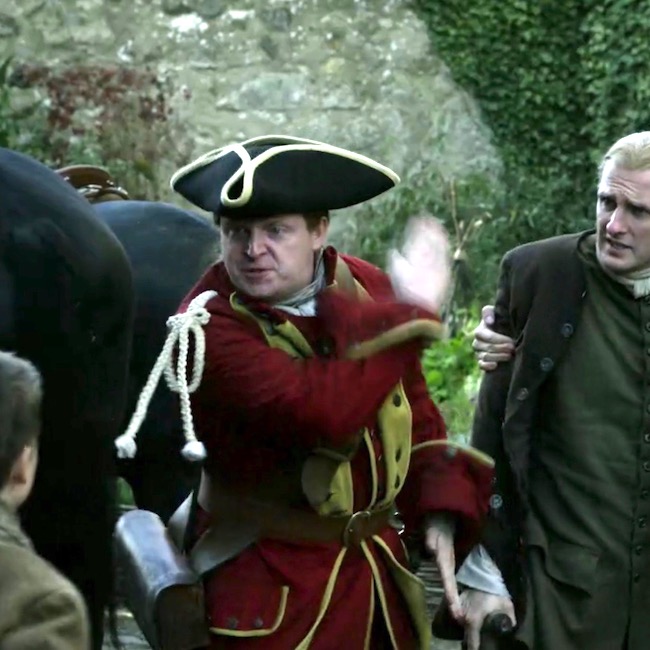
After repeat visits and more Redcoat insults, including crass threats to new mum, Jenny, Fergus leads Corporal MacGregor and pal on a taunt-jaunt. Soon, Fergus is trapped and the Low-lifer, erm, Lowlander, advances with a grimace and drawn blade!

A volley of yells, a brief struggle, a flash of the sword and… the unbelievable! Fergus’ clever hand with its nimble fingers is gone! From Voyager book, we share Jamie’s disbelief:
The shouting ceased abruptly in shocked silence. He scarcely heard when it resumed; it sounded so much like the roaring in his ears. His knees gave way, and he realized dimly that he was about to faint. His vision darkened into reddish black, shot with stars and streaks of light—

And more sad words from Voyager book to describe the horrific event:
…but not even the encroaching dark would blot out the final sight of Fergus’s hand, that small and deft and clever pickpocket’s hand, lying still in the mud of the track, palm turned upward in supplication.

In the TV version, Jamie rushes to the rescue, applying a pressure bandage to end of Fergus’ forearm, followed by a belt tourniquet. Jamie knows the drill, having watched his white woman deal with similar wounds of war. (Psst… in Voyager book, the Redcoats have the decency to return Fergus to Lallybroch)
Why, oh, why didn’t Jamie intervene to alter Fergus’ Fate? In emotional agony, he declares to his sib:
I should have stopped them!
Never one to mince words, TV Jenny tells it true:
Then ye’d be dead and so would he. We’d all be dead!

Jenny uses her own hard-earned wisdom derived from Ian’s leg loss to mend and attend Fergus’ stump.
Later, sitting up, but preferring French wine to Scotch whisky, Fergus tells Jamie “In one stroke, I have become a man of leisure!” Translation: Jamie must heed his Paris pledge to support a maimed Fergus for the rest of his life!
Jamie asks if it hurts, and Fergus answers that the wound:
Hurts a bit. Sometimes, it feels warm or scratchy or hurts like it is still there.
Later, Ian reassures Jamie:
My leg. It’s not there as anyone can plainly see. And, yet, it pains me terrible.
So, how is it that Ian’s missing leg stills pains him and how can Fergus still feel a hand left behind on the forest floor?
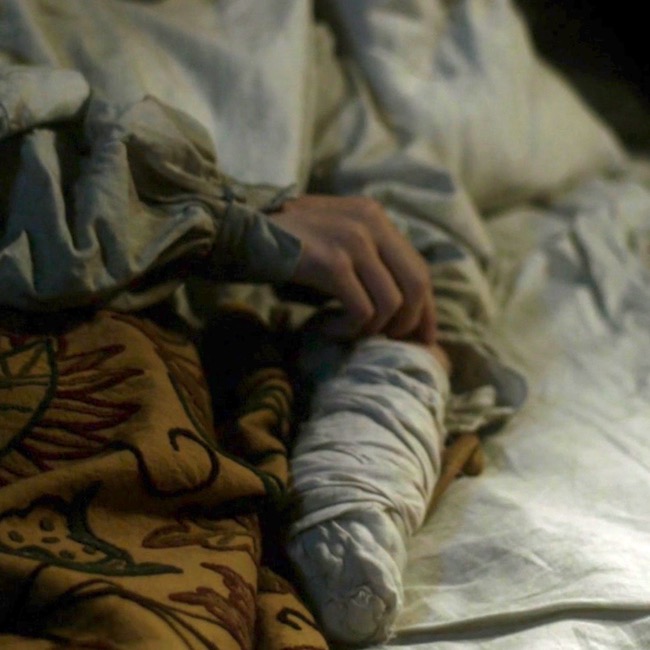
Anatomy Lesson to the rescue!
Phantom Limb Syndrome (PLS): Fergus and Ian describe sensations known as Phantom limb syndrome or PLS. PLS is the feeling that a lost limb is still present. Some 60 to 80% of amputees experience the sensation of an amputated limb and/or lost digits still being attached (Image A). Even people born with an absent limb or digit can experience PLS.
Interestingly, although PLS refers to the loss of a limb (and/or digits), some people report phantom sensation following the loss of other body parts such as breast, eye, nose, tongue, bowel, urinary bladder, or male phallus! Yes, they can perceive such missing parts as if still present!
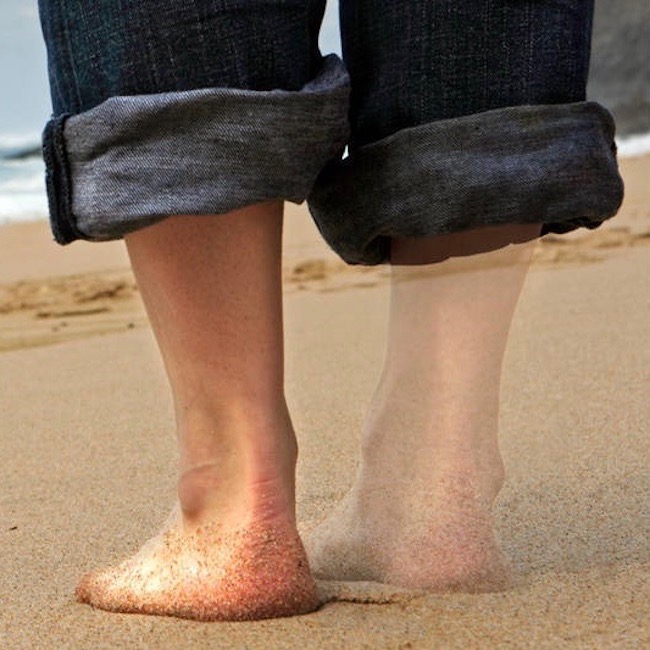
Image A
History: Understand that PLS is not new; it was first described almost 500 years ago by the brilliant French surgeon, Ambroise Paré. Paré operated on wounded soldiers and wrote in detail about patients who complained of pain in amputated limbs (Image B). Just so you know, Paré came up with such inspired and innovative surgeries to cope with physical trauma, he earned the sobriquet, the Father of Modern Surgery!
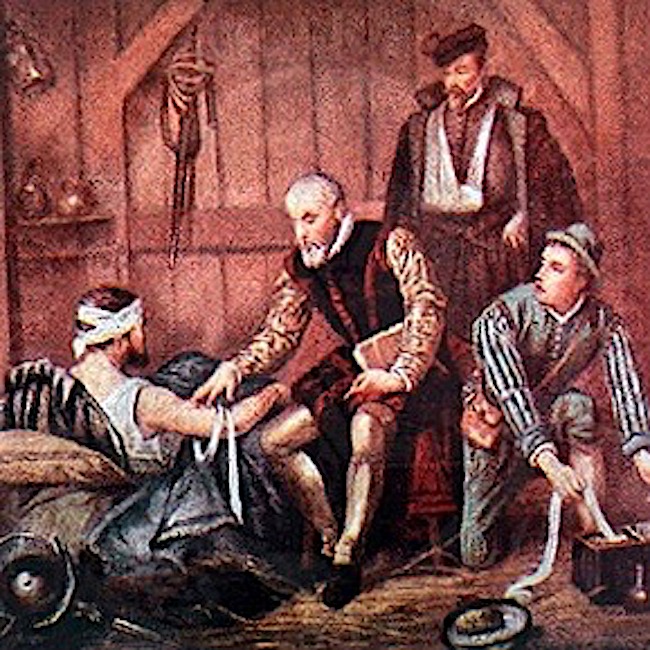
Image B
Herself does a fine job explaining phantom limb syndrome. Here, a quote from Voyager book, albeit from much later in the voyage! <G>
Innes came voluntarily to call upon me in my cabin a week later. “I am wondering, mistress,” he said politely, “whether there might be a medicine for something as isna there.” “What?” I must have looked puzzled at this description, for he lifted the empty sleeve of his shirt in illustration. “My arm,” he explained. “It’s no there, as ye can plainly see. And yet it pains me something terrible sometimes.” He blushed slightly. “I did wonder for some years was I only a bit mad,” he confided, in lowered tones. “But I spoke a bit wi’ Mr. Murphy, and he tells me it’s the same with his leg that got lost, and Fergus says he wakes sometimes, feeling his missing hand slide into someone’s pocket.” … “So I thought maybe if it was a common thing, to feel a limb that wasn’t there, perhaps there was something that might be done about it.”
“I see.” I rubbed my chin, pondering.“Yes, it is common; it’s called a phantom limb, when you still have feelings in a part that’s been lost. As for what to do about it.…”
Back to the lesson! So sorry, but the next three slides and accompanying text are dense with new words and concepts. No way around it, so please hang in there!
Phantom Limb Pain (PLP): People with PLS report sensations in the missing part including itching, motion, burning, gesturing, tickling, pain, etc. Sadly, pain is by far the most common experience. For some amputees, PLP is intermittent and the frequency and intensity of attacks may decline over time. With others, limb loss leads to debilitating pain. Although theories are plentiful, scientists have not been able to fully explain PLP.
You might recall this fellow from yesterday’s teaser (Image C)? This is the sensory homunculus (i.e. very small humanoid creature). Weird looking, it is a visual representation of sensations the brain recognizes from different areas of the body. Understanding the homunculus will help us understand the theories used to explain PLS and PLP.
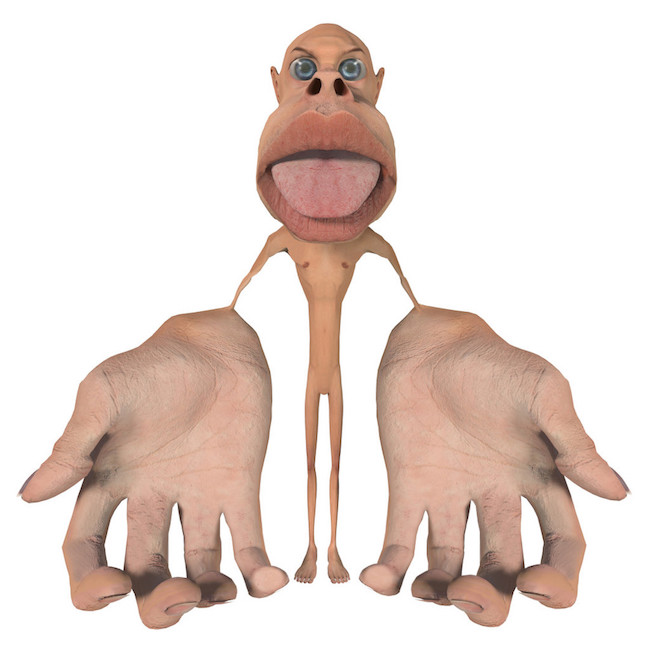
Image C
Sensory Homunculus: Scientists do know this (short and sweet): The entire human body, excepting brain and spinal cord (go figure!), is supplied with specialized sensory receptors. When stimulated, these receptors send signals to brain cells (neurons) of the sensory cortex (Image D – pink strips). Here, incoming sensory signals are interpreted as pain, heat, cold, touch, pressure, vibration, etc. There is a sensory cortex for the right side of body and one for the left.
And, just to be thorough, a similar adjacent area (Image D – green strip), the motor cortex, contains motor neurons which send outgoing signals to skeletal muscles, stimulating them to contract. Same for the motor cortex: one for the right side and for the left side of body.
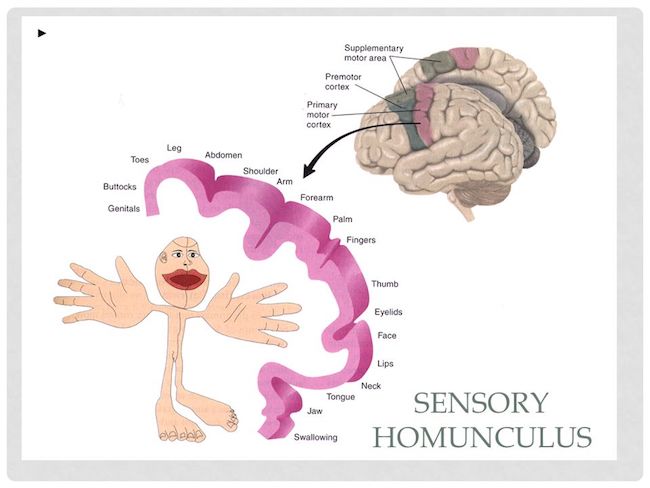
Sensory Homunculus (cont.): Those signals sent by sensory receptors are carried to prescribed areas of the sensory cortex based on their origin. Thus, if nerve endings in the great toe are stimulated, these signals end up in the area of the sensory cortex assigned to the big toe. If signals originate at the tongue, they end up in the sensory cortex assigned to the tongue. Ergo, the entire body is mapped out in the sensory cortex so signals are directed to their proper destination.
Such a sensory map assumes the shape of a small human and hence the term, sensory homunculus. BTW, the enlarged face, hands and feet (and genitals, which for the sake of sensitivity are not shown) aren’t meant for humor, these simply indicate anatomical areas with the greatest number/density of sensory receptors (Image E).
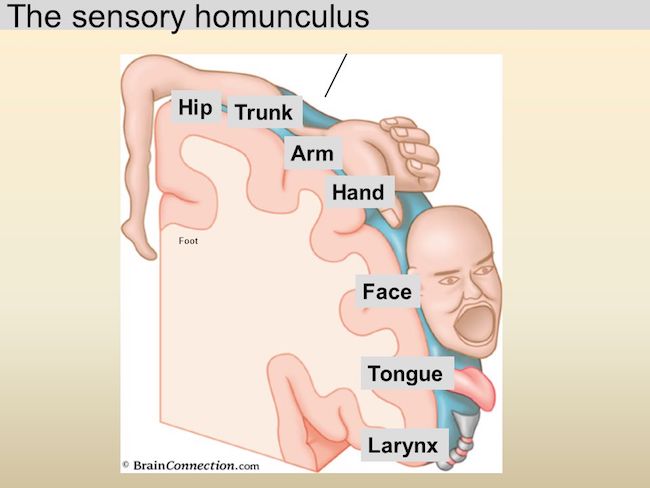
Image E
Theories: All of this sensory cortex business produces theories designed to explain phantom limb syndrome.
- Neuroma: Amputation severs sensory nerves, depriving them of contact with their sensory receptors. The traumatized nerve stumps develop neuromas (benign nodules). This theory proposes neuromas are hyper-excitable and discharge spontaneously sending anomalous signals to the brain that are interpreted as pain. Operating under this assumption, surgeons have performed second amputations, shortening the stumps, to remove the dysfunctional nerve endings in the hope of relieving pain. Tragically, sufferers can be left with pain not only from the original phantom limb but also the new phantom stump! A better approach uses chemical compounds to alter neuroma hypersensitivity, although this doesn’t work on all amputees.
- Spinal Cord: Most sensory nerves transmit messages up the spinal cord before they end in the brain’s sensory cortex. The spinal cord theory suggests that connections between the cut sensory nerves and the spinal cord are compromised resulting in hypersensitivity that is perceived as pain. This theory is problematic because some people born without limbs experience PLS and PLP even though they lack truncated sensory nerves. And, it fails to explain people who report phantom symptoms after the loss of nose or tongue. Sensation from the face bypasses the spinal cord, passing directly to the brain so the theory doesn’t account for routes that bypass the spinal cord. Hence, more studies are needed.
- Brain: The brain appears to contain an innate, hard-wired template of fully-formed body parts (neuromatrix). This template is continuously updated by ongoing conscious awareness and perception of the body, a process known as neural plasticity. Deprived of input, as with amputation, the brain generates an abnormal body perception that is interpreted as pain. Pretty interesting. But, get this: The brain most certainly can rewire itself because touching the stump of a missing arm is felt on the face of some amputees. Here, it is reasoned that facial neurons of the sensory cortex, located close to arm sensory neurons, take over after amputation, thus rearranging the neuromatrix.
The bottom line? Scientists have yet to prove which if any of these theories are correct. Perhaps each possesses a piece of the puzzle? Much research is being focused on this issue because there are far more amputees in today’s western world due to war.
The following is an excellent video quickly explaining PLS and PLP. Unfortunately, it doesn’t stop at the end and other videos begin to p lay. Just click on the stop bars to halt it. Hope you watch, anyway!
Back to Outlander: When TV Claire first encounters the tragedy of Fergus’ hand, he has adopted an 18th century prosthesis (Starz ep 307, A. Malcolm) to help compensate for his loss.
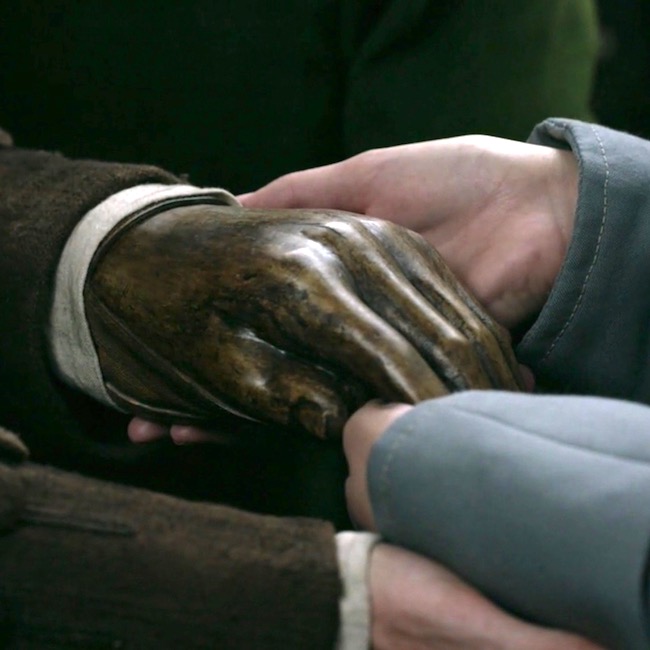
And, Marsali, aboard the Artemis, gives us a clue that TLC can be a big comfort to an amputee (Starz ep 309, The Doldrums)!
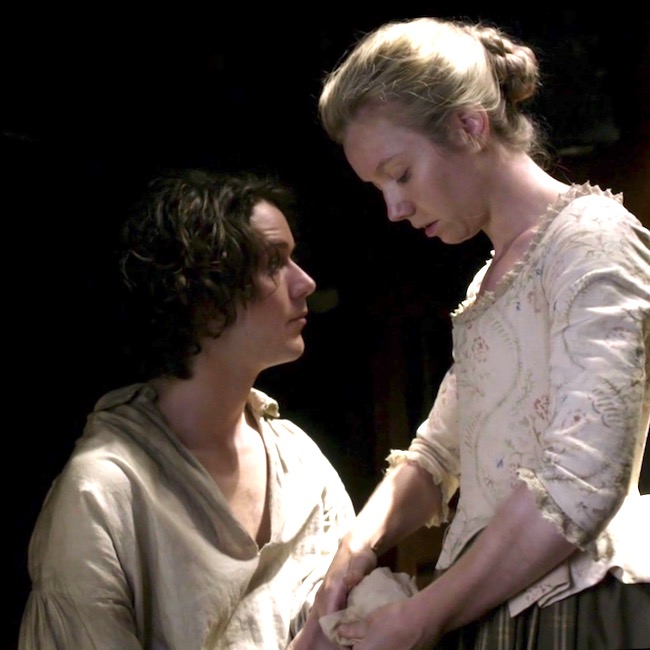
PLS Treatments: Today, there is hope as medical treatments for PLS and PLP are varied and imaginative! These include:
- Pharmaceuticals: NSAIDS, opioids, antidepressants, etc., with varying results.
- Nerve Stimulation: Nerves of the stump are stimulated with electrical currents to relieve pain. Varied success.
- Biofeedback: Acupuncture, biofeedback, ECT (electroshock therapy) to relieve PLP have yielded mostly inconsistent results.
- Mirror Box Therapy: In this interesting therapy, an amputee places the amputated limb behind a mirror while the intact limb is viewed in the mirror (Image F). The patient moves the intact limb while observing its image in the mirror. This “tricks” the brain into perceiving that the absent limb is moving. The technique has yielded some amazing success. The above video described a woman born with three fingers and a partial thumb. She accidentally lost the hand, subsequently experiencing unbearable PLP in the missing limb. Using a mirror box, she exercised her intact hand in the mirror, creating the illusion that the missing hand performed the tasks. After two weeks, she was able to “move” her phantom fingers and found pain relief! Even more amazing, she now perceives her absent hand as having five digits, all of normal lengths. More work to be done, but it has produced some very promising results!
- Limb Regeneration: Hot off the presses! The Dec. 2017 issue of New Scientist reports researchers at Tufts University have used bioelectricity to grow heads and tails on worms and boost the frog’s natural ability to regrow severed limbs. New experiments are planned to stimulate mice to regrow missing digits. Human limbs will be attempted at some point in the future.
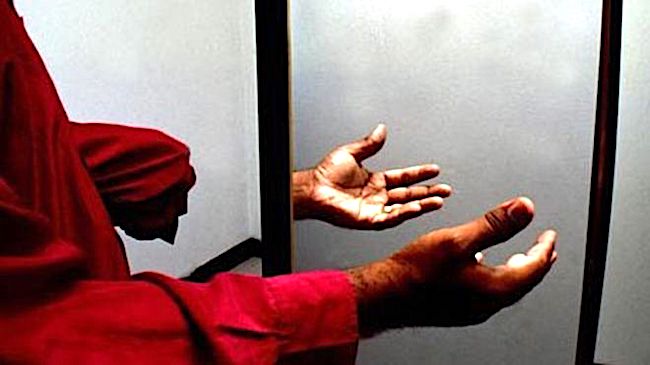
Image F
Swift and to the point, but the above pretty info much summarizes the current state of PLS and PLP research. OK, enough neuroscience. Back to Outlander!
Special Effects: I cannot let this pass unnoticed! How do you rate the special effects of Outlander ep 302, Surrender? Thumbs up? Thumbs down? I give two thumbs up! Here’s three good reasons why.
- Did you notice blood spurting from two sites at Fergus’ wrist? The large brachial artery (Anatomy Lesson #56, Achy Brachial Artery) supplies blood to the entire upper limb. It terminates near the elbow by dividing into two arteries, the radial and ulnar, both of which supply the hand (Anatomy Lesson #23, Harming Hands – Helping Hands – Healing Hands). Thus, two blood streams ejecting from Fergus’ stump are consistent with the anatomy of radial and ulnar arteries!
- Does blood spurt from a cut artery? Why, yes it can and does. This occurs at first because blood pressure through arteries is much higher than through veins. Shortly after being cut, the muscular walls of a severed artery spasm to help slow blood loss. And, the loss of blood through the open artery diminishes its blood pressure. Ergo, lower pressure = lower flow.
- Is Jamie’s first aid helpful? Yes! Applying pressure to cut vessels and application of a tourniquet help diminish blood loss; the first by reducing blood escaping from the open wound and the second by diminishing the amount of blood entering the damaged vessel.
Make sense? Awesome sauce! Way to go, Outlander team!

Hopefully, you learned something new in this lesson. Wish the definitive answer to PLS and PLP was available but research continues, unabated.
Let us close this lesson with a verra fine example of neuroplasticity!
Two hundred and two years and thousands of miles away, Claire experiences her own type of phantom pain! Missing her heart, she visualizes the core of her loss (Outlander episode 302, Surrender). Phantom, indeed! Hehe….

The deeply grateful,
Outlander Anatomist
Follow me on:
- Twitter @OutLandAnatomy
- Join my Facebook Group: OutlandishAnatomyLessons
- Instagram: @outlanderanatomy
- Tumblr: @outlanderanatomy
- Youtube: Outlander Anatomy
Photo creds: Sony/Starz; www.painresource.com (Image A); www.robotspacebrain.com (Image B); www.gravitywerks.com (Image C); www.slideplayer.com (Image D, E); www.bbc.com (Image F)
